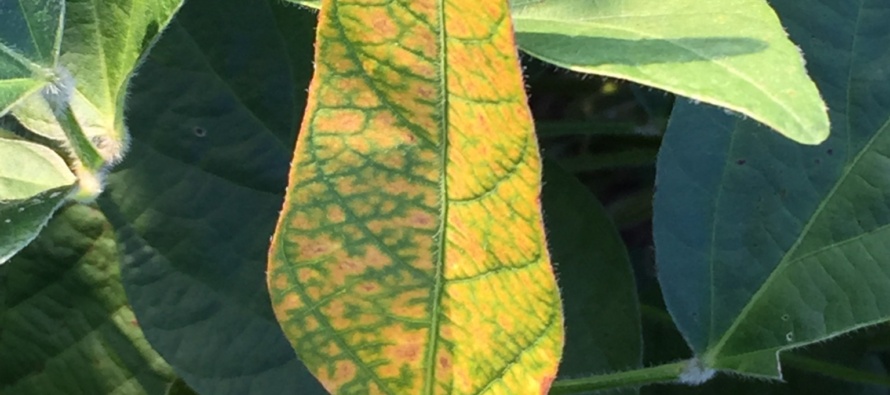Soybean Root Disease Update: August 3, 2016

Related Articles
- 2010 Soybean And Corn Variety Trial Data 3
- Rice Variety Trial Results For 2010, Plus Rice Research Report 0
- Evaluation of Peanut Prescription Rx Program in Mississippi 0
Latest Tweets

Plants exhibiting taproot decline (TRD) generally have leaf tissue with veins that remain green in color while the rest of the leaf turns a bright yellow.
Taproot decline (TRD)
In general, over the past several seasons, taproot decline (TRD) has been observed extensively in the month of August. TRD can most easily be observed in soybean plants that have reached the R6 growth stage, or are somewhere between R5.5 and R6. Plants that exhibit interveinal chlorosis in small groups of plants, generally two to five, with leaves presenting a bright yellow chlorosis having green veins are normally diagnosed with TRD. However, the foliar symptoms associated with TRD can differ between fields, but is generally associated with slight coloration differences in the leaf tissue. Whereas plants infected with SDS produce interveinal necrosis (areas of the leaf between the veins that typically fall out of the leaf and appear dead) plants exhibiting TRD have leaf tissue without interveinal necrosis where the veins of the leaf remain green. Fields with suspected TRD should be scouted for the presence of the disease by gently removing plants from the soil profile with a shovel. Plants with TRD will generally have a dark, black fungal growth on portions of the root and stem below the soil line. In addition, the vascular tissue of the plant will be lightly stained brown when the stem is observed following the removal of the stem by cutting lengthwise. One last observation, of the breaking of the stem by snapping the stem at either the base of the soil line or slightly below the soil line will normally distinguish TRD from the other root and stem diseases. If the stem at the base of the plant appears brittle the disease present is more than likely TRD.
As a brief update regarding the TRD disease situation. A large task force of researchers from AR, LA and MS are working to determine the genus and species of the fungus involved in causing the disease. At present, the group is positive they have gotten the fungus within a genus, but are still working to determine the species involved.

Foliar symptoms associated with root-knot nematode infestation. The interveinal chlorosis can be quite similar to other diseases so check roots for galling.
Root-knot nematode
As soybean plants reach advanced growth stages, generally preceding R6, the presence of root-knot nematode infestations can be observed. Root-knot nematodes generally prefer soils that contain a substantial sand content as compared to reniform nematodes that prefer a soil that contains more silt. Plants that develop interveinal chlorosis in either small patches, or large areas, should be removed from the soil profile. Observe roots for the presence of galling. Galls can oftentimes be difficult to differentiate from nodules. Be mindful that galls will surround the roots whereas nodules are typically attached to the root. Root-knot galls will also form hardened structures that will hold soil when removed from the soil profile. Rinse off roots and observe for galls. In fields having a history of cotton production, or poor rotational strategies that may include corn, cotton and soybean rotations collect soil samples and submit to the diagnostic laboratory for analysis.

Root-knot nematode galling. Note that galls will surround roots, are hardened, can sometimes hold soil when removed, but can oftentimes be confused with nodules.
Fields exhibiting root-knot nematode infestations should be rotated to a non-host for 2017 or a resistant/tolerant soybean variety planted. Keep in mind that corn is not a non-host for the southern root-knot nematode.
For aid in selecting varieties that may be more tolerant of the root-knot nematode, refer to:




Let me tell You a sad story ! There are no comments yet, but You can be first one to comment this article.
Write a comment